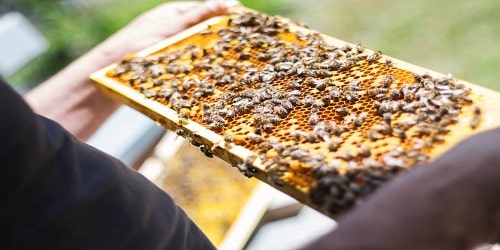Beekeeping Meaning
The word beekeeping derives from the integration of two Latin words, “apis” which means bee, and “cultus”, to cultivate or breed, being the result of a French neologism, used to designate the art or scientific discipline that deals with the breeding of bees. , honey-producing insects, which live in colonies, called hives.
Beekeeping can date back to Prehistory. Since the formation of the first States, man continued to take advantage of the work of bees, especially as producers of honey for his own benefit, and also wax, to make candles and lamps. At the beginning of ancient times, the Egyptians did it, a trade that was later carried out by the Greeks and Romans, who appreciated the sweetness of this substance, in times when the sweetening properties of sugar cane, discovered with the discovery of the continent, were not yet known. American.
Bees store the nectar they collect from flowers, and transform it into a sweet and substantial product, called honey, which they store in honeycombs, made up of thousands of hexagonal cells. This honey is used by bees to feed themselves in the cold winter months.
Free-living bees build their hives with mud, animal hair, and chewed leaves. However, beekeepers make artificial hives, which they place in their gardens, and take care of them, to extract honey in the spring and summer months. . They also make royal jelly, very rich in vitamins and proteins, with which the larvae of those bees that will become queens are fed. Beekeepers also extract this royal jelly, and with it they make soaps, facial creams, and vitamins in capsules.
In the 20th century, ecological beekeeping emerged, which carries out this practice taking care of the environment and without using pesticides.
Beekeeping Meaning in Hindi
मधुमक्खी पालन शब्द दो लैटिन शब्दों के एकीकरण से निकला है, “एपिस” जिसका अर्थ है मधुमक्खी, और “कल्टस”, जिसका अर्थ है खेती करना या प्रजनन करना, एक फ्रांसीसी नवशास्त्र का परिणाम है, जिसका उपयोग मधुमक्खियों के प्रजनन से संबंधित कला या वैज्ञानिक अनुशासन को नामित करने के लिए किया जाता है। , शहद बनाने वाले कीड़े, जो कॉलोनियों में रहते हैं, जिन्हें छत्ते कहा जाता है।
मधुमक्खी पालन का इतिहास प्रागैतिहासिक काल से है। पहले राज्यों के गठन के बाद से, मनुष्य मधुमक्खियों के काम का लाभ उठाता रहा, खासकर अपने फायदे के लिए शहद के उत्पादक के रूप में, और मोमबत्तियाँ और दीये बनाने के लिए मोम भी। प्राचीन काल की शुरुआत में, मिस्र के लोग इसे करते थे, एक ऐसा व्यापार जो बाद में यूनानियों और रोमनों द्वारा किया गया, जिन्होंने इस पदार्थ की मिठास की सराहना की, ऐसे समय में जब महाद्वीप की खोज के साथ खोजे गए गन्ने के मीठे गुणों के बारे में अभी तक पता नहीं चला था। अमेरिकी।
मधुमक्खियाँ फूलों से एकत्रित अमृत को संग्रहित करती हैं, और इसे एक मीठे और पर्याप्त उत्पाद में बदल देती हैं, जिसे शहद कहा जाता है, जिसे वे हज़ारों षट्कोणीय कोशिकाओं से बने छत्ते में संग्रहित करती हैं। इस शहद का इस्तेमाल मधुमक्खियाँ ठंड के महीनों में खुद को खिलाने के लिए करती हैं।
मुक्त रहने वाली मधुमक्खियाँ मिट्टी, जानवरों के बाल और चबाए हुए पत्तों से अपने छत्ते बनाती हैं। हालाँकि, मधुमक्खी पालक कृत्रिम छत्ते बनाते हैं, जिन्हें वे अपने बगीचों में रखते हैं और उनकी देखभाल करते हैं, ताकि वसंत और गर्मियों के महीनों में शहद निकाला जा सके। वे रॉयल जेली भी बनाते हैं, जो विटामिन और प्रोटीन से भरपूर होती है, जिससे उन मधुमक्खियों के लार्वा को खिलाया जाता है जो रानी बन जाती हैं। मधुमक्खी पालक इस रॉयल जेली को भी निकालते हैं और इससे वे साबुन, फेशियल क्रीम और कैप्सूल में विटामिन बनाते हैं।
20वीं सदी में, पारिस्थितिक मधुमक्खी पालन का उदय हुआ, जो पर्यावरण की देखभाल करते हुए और कीटनाशकों का उपयोग किए बिना इस अभ्यास को अंजाम देता है।

